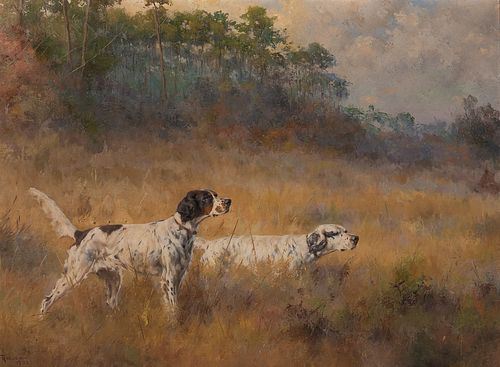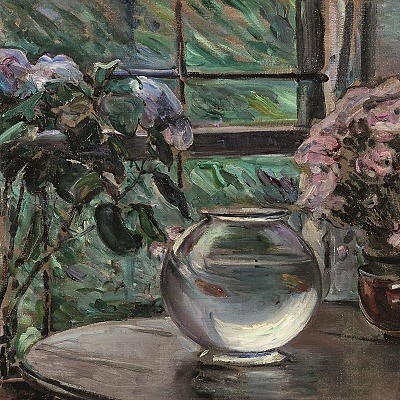Percival Leonard Rosseau (American, 1859-1937) The First Brace/Two Setters in a Landscape
Lot 34
About Seller
Bonhams Skinner
274 Cedar Hill Street
Marlborough, MA 01752
United States
Founded over four decades ago, Bonhams Skinner offers more than 60 auctions annually. Bonhams Skinner auctions reach an international audience and showcase the unique, rare, and beautiful in dozens of categories, including the fine and decorative arts, jewelry, modern design, musical instruments, sc...Read more
Categories
Estimate:
$30,000 - $50,000
Absentee vs Live bid
Two ways to bid:
- Leave a max absentee bid and the platform will bid on your behalf up to your maximum bid during the live auction.
- Bid live during the auction and your bids will be submitted real-time to the auctioneer.
Bid Increments
| Price | Bid Increment |
|---|---|
| $0 | $10 |
| $100 | $25 |
| $500 | $50 |
| $1,000 | $100 |
| $3,000 | $250 |
| $5,000 | $500 |
| $10,000 | $1,000 |
| $30,000 | $2,500 |
| $50,000 | $5,000 |
| $100,000 | $10,000 |
| $300,000 | $25,000 |
| $500,000 | $50,000 |
| $1,000,000 | $100,000 |
About Auction
By Bonhams Skinner
Sep 30, 2021
Set Reminder
2021-09-30 10:00:00
2021-09-30 10:00:00
America/New_York
Bidsquare
Bidsquare : American Works of Art
https://www.bidsquare.com/auctions/skinner/american-works-of-art-7485
Early 19th century painters through early Modernists are represented, including works by Arthur Dove, Percival Rosseau, Granville Redmond, Elizabeth Nourse, Marguerite Zorach, and the under-documented Hudson River School painter Louisa Davis Minot. Bonhams Skinner bidsquare@bonhamsskinner.com
Early 19th century painters through early Modernists are represented, including works by Arthur Dove, Percival Rosseau, Granville Redmond, Elizabeth Nourse, Marguerite Zorach, and the under-documented Hudson River School painter Louisa Davis Minot. Bonhams Skinner bidsquare@bonhamsskinner.com
- Lot Description
Percival Leonard Rosseau (American, 1859-1937)
The First Brace/Two Setters in a Landscape
Signed and dated "Rosseau/1935" l.l., titled and inscribed on the reverse.
Oil on canvas, 28 1/4 x 38 3/8 in. (71.5 x 97.5 cm), in a Newcomb-Macklin frame.
Condition: Old retouch to the sky, minor canvas deformation at u.l. corner, craquelure, varnish discoloration, surface grime.
Provenance: The Townshend Estate, New Haven, Connecticut. Spanning five generations and over 200 years of family history, the Townshend Estate at 709 Townsend Avenue in New Haven is now a local landmark. The Townshend family purchased the original 79 acres of farmland in 1798 and erected the main house in 1804, changing and expanding the structure over time. The last owners, Henry Townshend Jr. and Doris B. Townshend, lived in the house for over 60 years. Active in the local community, Henry Jr. served as an alderman for New Haven for many years, and even twice ran for mayor. Along with his work as a proprietor of the New Haven Green and a Trustee of the Union Trust Co., among other positions, Henry Jr. bred and trained English setters for competition. Skinner is pleased to offer more items from this important estate in the upcoming online auction: A Gilded Age: New England Collects Europe, September 27th through October 7th.
N.B. Combining his natural gifts, a passion for hunting, and professional art training, Percival Leonard Rosseau became a premier sporting artist. He was born in Louisiana on a farm his family had received as a land grant from Louis XIV, where his ancestors raised Franc Comptoise hunting dogs with bloodlines imported from Normandy. The farm was ruined during the Civil War, and much of his family were either killed or died. He and his sister escaped and were raised by a family friend in Kentucky, where Rosseau learned to shoot and fish. As a young man, he tried his hand at several trades, including cattle driving in Texas where he hunted mountain lions with a pack of hunting dogs he brought from Louisiana. After founding a successful import brokerage business in New Orleans, in the early 1890s he decided to depart for Paris to study art, enrolling at the Acad?mie Julian. By 1904 he was exhibiting hunting paintings at the Paris Salon which won him acclaim and cemented his reputation as a sporting and animal artist. While still fulfilling commissions for patrons in the United States, Rosseau remained in France until 1915, returning to the United States during World War I and settling in Lyme, Connecticut, where he was involved with the artists' colony at Old Lyme. He also worked in the southern United States at the behest of his wealthy patrons, one of whom, Percy Rockefeller, built a studio for him and lent him gun dogs to use as models at the bucolic retreat Overhills, in Fayetteville, North Carolina.
Biography based upon F. Turner Reuter Jr., Animal & Sporting Artists in America (Middleburg, Virginia: The National Sporting Library, 2008), pp. 612-13.Condition
Condition: Framed dimensions are 32 1/2 x 42 5/8 x 1 3/4 inches.
There is a thin particle board panel inserted between the stretcher and the canvas which seems original to the framing of the work and which is inscribed with the title. The canvas is not laid down on the board.
The canvas deformation mentioned above is similar to what we have seen occur when a stretcher key has come loose and lodged under the stretcher, although one can't see well enough in this case to be sure. The resulting canvas bulge extends diagonally for about 3 inches from the u.l. corner and is about 1 inch wide. The craquelure is to the u.l. quadrant and presents as long diagonal lines.
Any condition statement is given as a courtesy to a client, is only an opinion and should not be treated as a statement of fact. Skinner Inc. shall have no responsibility for any error or omission. The absence of a condition statement does not imply that the lot is in perfect condition or completely free from wear and tear, imperfections or the effects of aging. - Shipping Info
-
Please visit http://www.skinnerinc.com/services/payment-and-shipping/ for information regarding the collection of items purchased at auction.
-
- Buyer's Premium



 EUR
EUR CAD
CAD AUD
AUD GBP
GBP MXN
MXN HKD
HKD CNY
CNY MYR
MYR SEK
SEK SGD
SGD CHF
CHF THB
THB

























